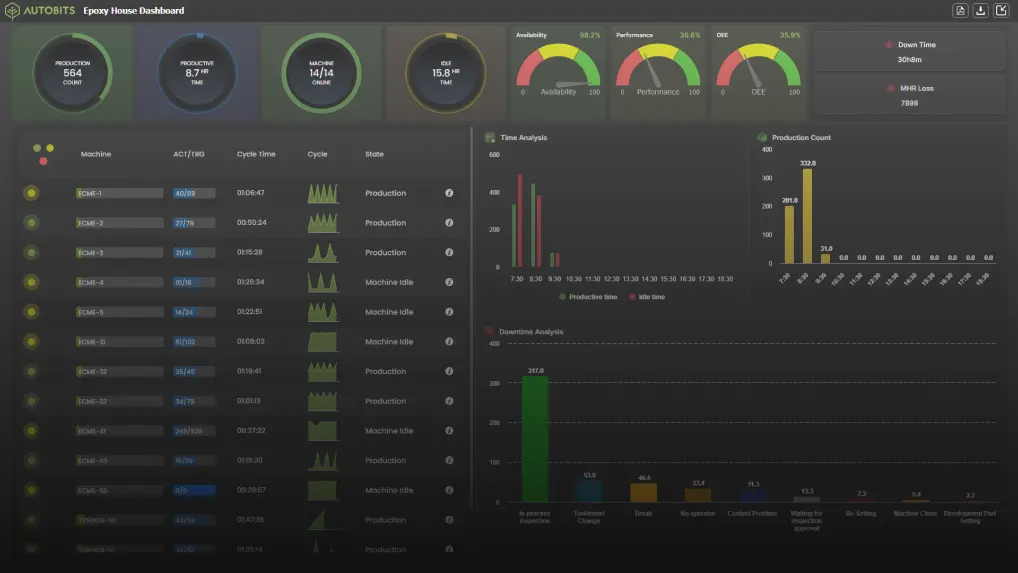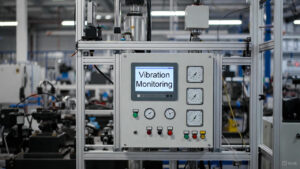Problem in CNC Machine shop
A manufacturing unit producing engine components for the automotive industry had a dedicated team of supervisors tasked with increasing output. However, despite their efforts, production capacity remained stagnant, and the root cause of low productivity remained elusive. The supervisors were using outdated methods of data entry and spreadsheet calculations, which were time-consuming and inefficient. The data they collected was rarely reported to higher management, and there was no call to action based on the data being collected.
Solution with Industry 4.0
Autobits, a provider of Industry 4.0 and IoT solutions, audited the manufacturing facility and identified significant opportunities for KPI monitoring. Autobits proposed real-time KPI monitoring to improve productivity and reduce losses, focusing on KPIs such as OEE (A,P,Q), MHR Loss, cycle time deviation, operator tracking, and energy cost. Data was acquired from CNC controllers using Autobits’ Industry 4.0 gateway and transformed into actionable reports, dashboards, and alarms.
The solution was designed to be user-friendly and seamlessly integrated with existing systems, reducing the need for additional investment in hardware or software. The real-time data access enabled data-driven decision-making, allowing operators and supervisors to take corrective actions and increase efficiency.
The solution also provided the ability to track operator performance, which helped to improve accountability and transparency in the production process. This targeted training to improve operator performance, which resulted in increased efficiency and profitability for the manufacturing unit.
Results with Machine monitoring solution
By processing the right KPIs, Autobits was able to increase productivity by 27% and reduce losses by up to 8%. This had a transformative impact on the human experience of the workplace, with relief and satisfaction felt by both supervisors and operators. Before Autobits’ solution was implemented, the supervisors were frustrated and helpless as they struggled to increase production capacity but were unable to identify the root cause of low productivity.
The pressure felt by the operators to meet production targets led them to manipulate data and prioritize quantity over quality. Autobits’ solution provided a solution to these challenges, leading to joy among the supervisors as they were finally able to identify the root cause of low productivity and take proactive steps to address it. The operators were proud to contribute to the success of the manufacturing unit by providing accurate data and focusing on quality.
The reduction in paperwork has elevated supervisors from data entry to data analytics, enabling them to focus on root cause analysis (RCA) and improve productivity. With the help of accurate and live data, damages and losses are now prevented before they occur, which has led to a decrease in overall production costs.
Long-Term Benefits of Industry 4.0
One of the long-term benefits of implementing KPI monitoring is that it provides a watchdog that automatically records all data without the need for human intervention. Management no longer needs to rely on supervisors to send data or for operators to give accurate data, as Autobits’ system captures data automatically. This has led to increased trust in the data being collected and greater transparency in the production process.
In addition, Autobits’ KPI monitoring solution has enabled the manufacturing unit to identify areas for improvement and take proactive steps to prevent losses, resulting in increased profitability over the long term.
Conclusion
Through its innovative use of Industry 4.0 and IoT solutions, Autobits has transformed a struggling manufacturing unit into a high-performing, data-driven operation. By harnessing the power of real-time KPI monitoring, Autobits has helped the manufacturing unit to increase productivity, reduce losses, and improve overall efficiency. With a ROI of less than six months, the benefits of implementing Autobits’ solution are clear. The manufacturing unit now has a competitive advantage in the marketplace and is well-positioned for their growth.





